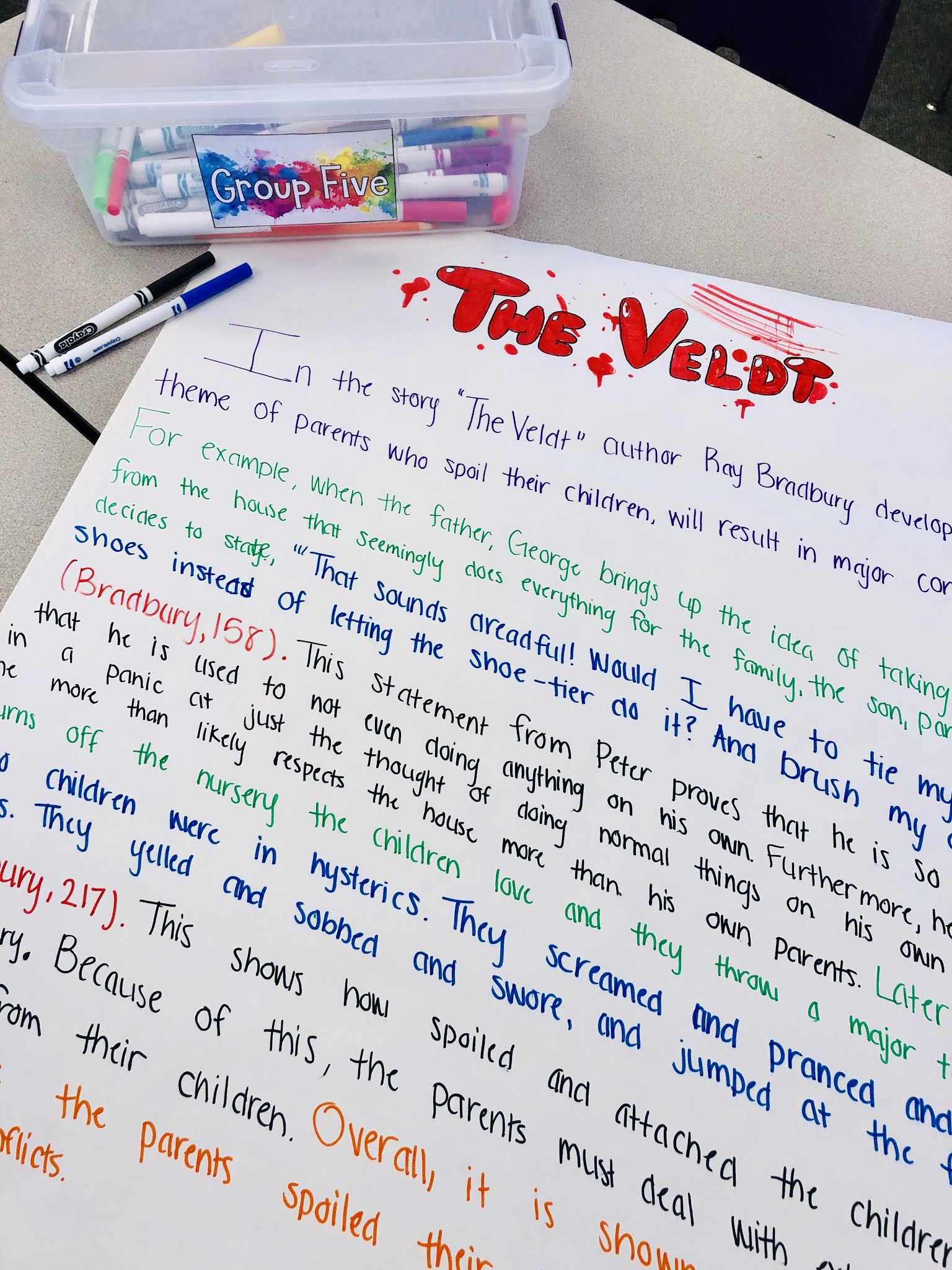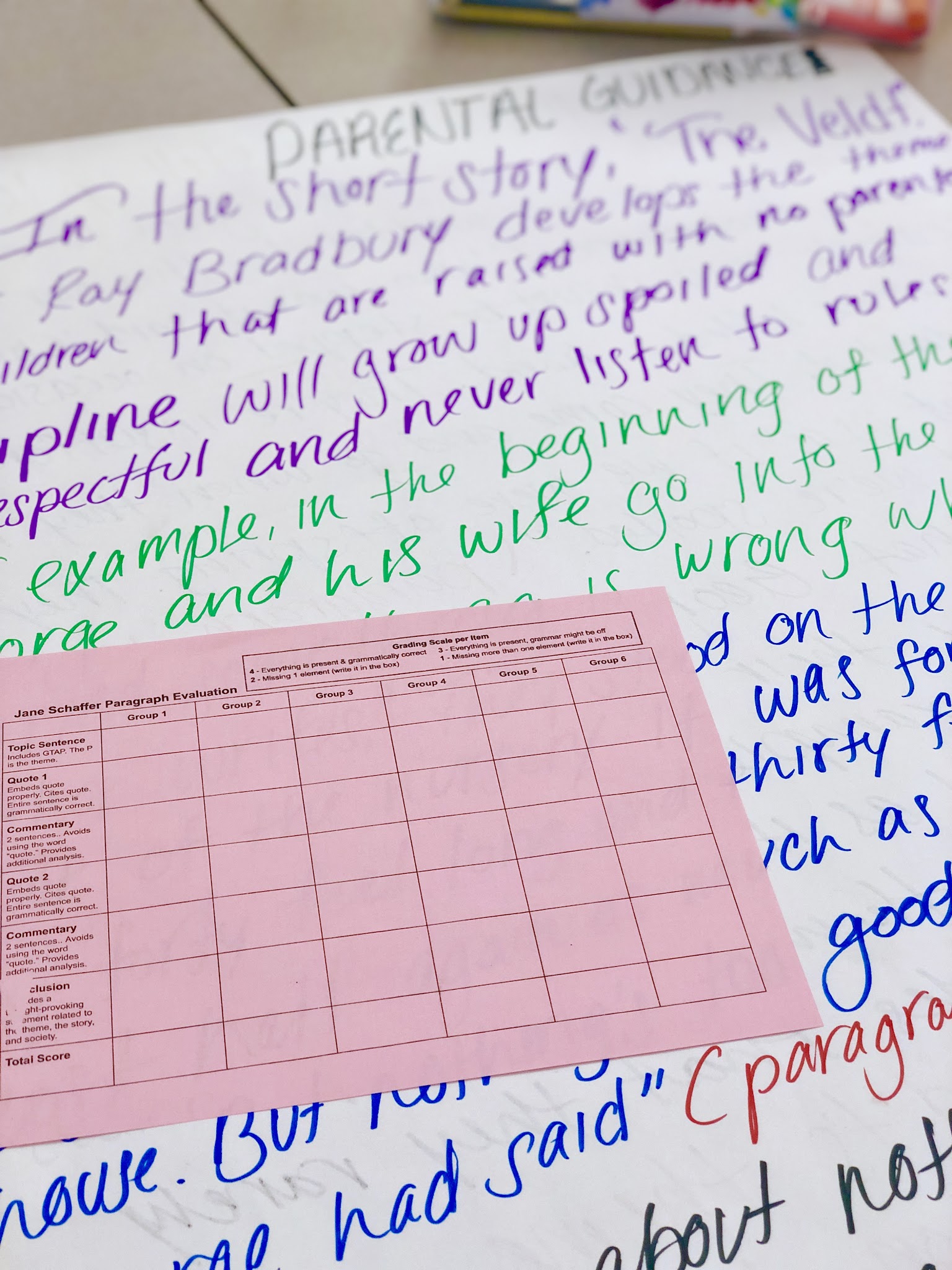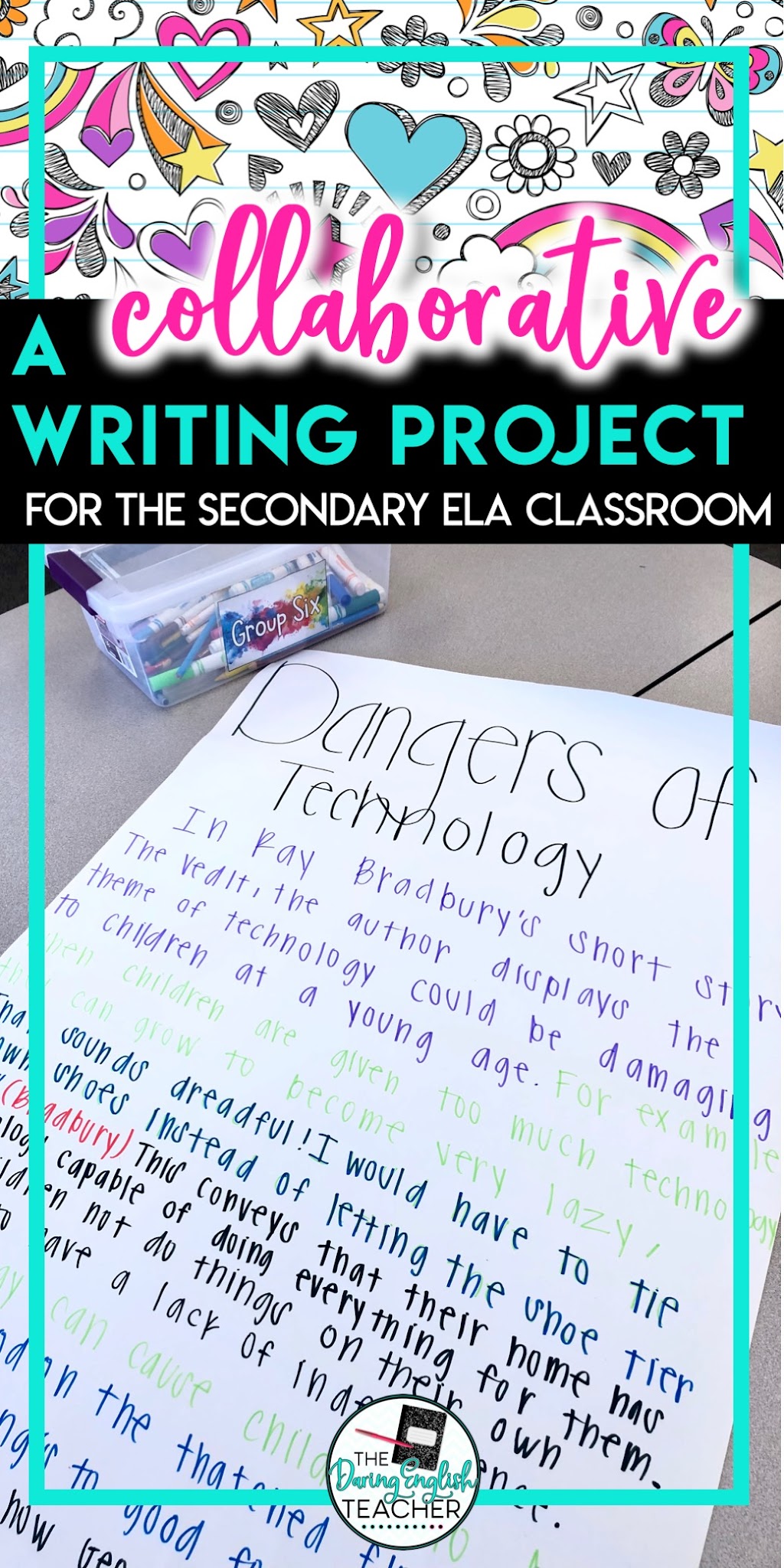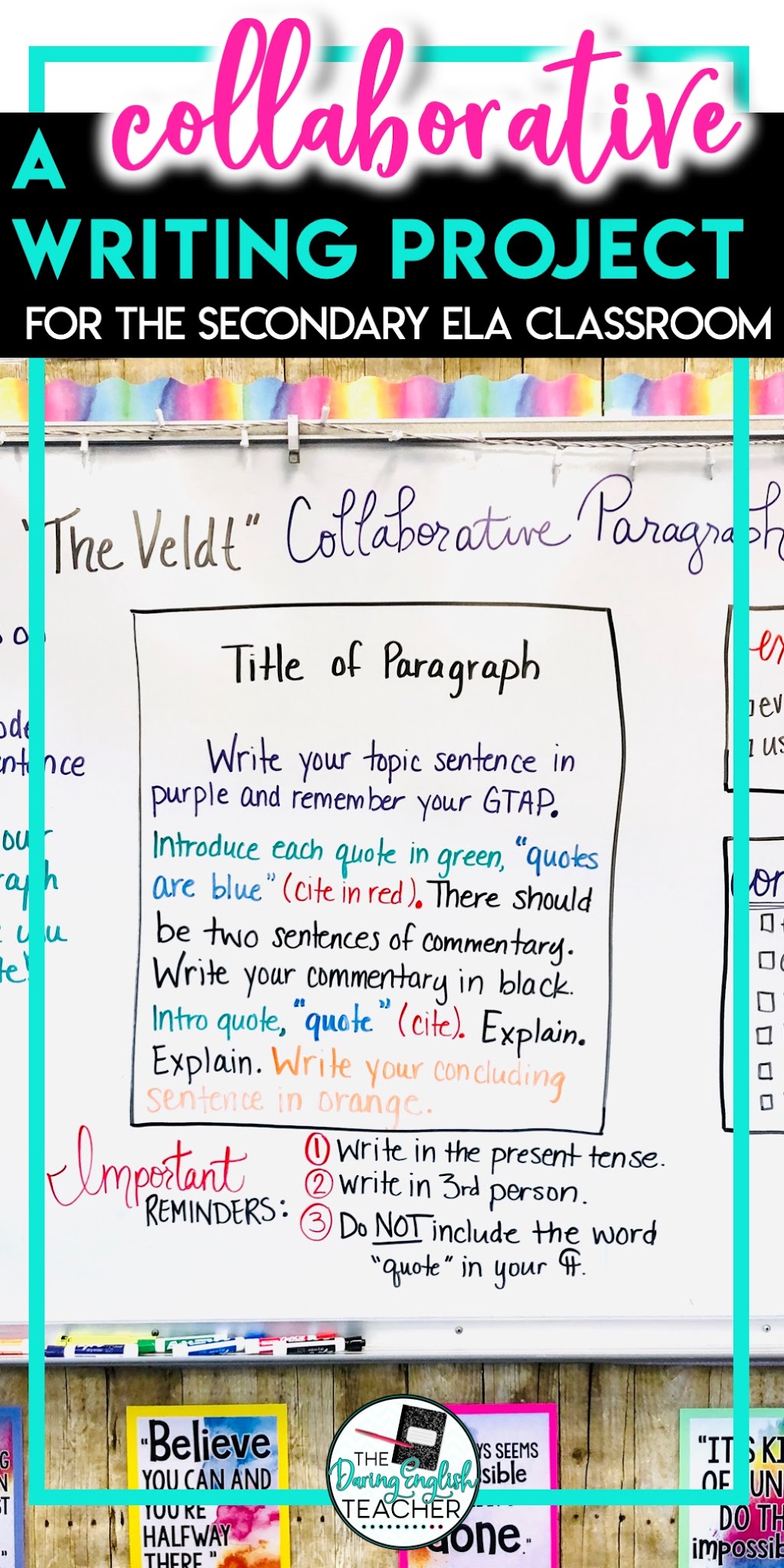In an earlier blog post, I wrote about the benefits of assigning a collaborative writing assignment in the high school English and middle school ELA classroom. In the post, one of the benefits included less grading. And to be completely honest, that is why I switched up my sophomores’ recent short story paragraph about “The Veldt.” I was already behind on grading various writing assignments, and so I decided a collaborative paragraph was the way to go.
As I switched gears from an individual Jane Schaffer literary analysis paragraph to a collaborative paragraph, I thought about how I could make the activity even more beneficial for my students. It was still early in the school year, and I was still working on writing instruction with my students -primarily on how to properly embed quotes and write thoughtful commentary. So, I decided to have my students color-code each element of the paragraph. This was my way to get students actively thinking about every single paragraph element. Not only did they need to include these various elements in their paragraphs, but they also needed to color-code them to show me that they understood the aspects.
For the paragraph, students analyzed how Ray Bradbury developed the theme in his short story “The Veldt.” This is a prompt that comes straight from the standards, and students needed to identify how the theme emerged, and how Bradbury fully developed it by the end of the story.
I wrote out explicit directions for the collaborative paragraph assignment on my whiteboard. I even color-coded it to show my students exactly how I wanted them to color-code their paragraphs.
Paragraph Color-Coding Instructions
Sentence 1: Topic Sentence
Write the topic sentence in purple. For the topic sentence, my students needed to include the GTAP: genre, title, author, purpose (of the paragraph -in this case, the purpose was to show how Bradbury developed the theme).
Sentence 2: Concrete detail #1
Students introduced the quote in green, wrote the quote in blue, and provided the MLA parenthetical citation in red. This quote was the first event from the story in which they felt the theme emerged.
Sentences 3-4: Commentary
Students wrote their commentary that explained the quote and analyzed how the event connected to the purpose of the paragraph in black. For commentary writing, I don’t allow my students to include the word “quote.” It’s a tough habit to break, but they can manage it with practice.
Sentence 5: Concrete detail #2
Like above, students introduced the quote in green, wrote the quote in blue, and provided the MLA parenthetical citation in red. This quote was a subsequent event from the story that showed the theme fully-developed.
Sentences 6-7: Commentary
Students wrote their commentary that explained the quote and analyzed how the event connected to the purpose of the paragraph in black. For commentary writing, I don’t allow my students to include the word “quote.” It’s a tough habit to break, but they can manage it with practice.
Sentence 8: Concluding Sentence
Students write this sentence in orange. For a theme-based literary analysis paragraph, students connect the theme back to society today.
How the Activity Worked
My students worked together in their table groups for this assignment. They sit in tables of either five or six students. While I think this would have been better in groups of 2-4, it did work with larger groups. To help encourage every student to participate actively, I provided my students with ways they could help their table groups. Then, I walked around and actively monitored their progress.
In all honesty, I thought this process would take one class period from start to finish, and it did not. My students needed an additional 15 minutes the following day to complete their paragraphs. However, I utilized the remaining time the second day for peer review.
One way that students become stronger writers is by reading what others write, and so that is what we did. On the second day, I had my students get together in smaller groups for the second component of the activity. They got into groups of 2-3 people, and they had to choose people outside of their table groups. In their new groups, students, went around the room and read and evaluated all of the paragraphs. I created a paragraph evaluation form, and with that form, students analyzed each paragraph on a sentence-by-sentence level.
You can download this peer evaluation form HERE!
Why Collaborative Writing Works
This assignment was a big success, and now that my students have gone through this process, I know that they’ve practiced proper Jane Schaffer writing. As they were working on their paragraphs, my students brainstormed together, wrote together, and edited their work together. Since it was a collaborative assignment, they did all of this out loud as they communicated with each other various ways to write and improve their paragraphs. Even for the students who were less hands-on during the writing process, they were present and overheard their peers work their way through a paragraph.
To reinforce everything that my students did together in their groups as they wrote their paragraphs, they then went around the room and read five other paragraphs. And even though they might not have realized it at the time, they were comparing and evaluative the paragraphs, and in that process, they became stronger writers.
Where I’ll Take This Next
Now that my students have completed this work, I have quite a few model paragraphs to hang up throughout my classroom. I’ll use these examples as model texts as we continue our short story unit and begin to start writing our first multi-paragraph of the school year.
While I purposefully include strategies like this that haver built-in scaffolding and differentiation for my EL students and students with IEPs, these strategies help all learners. Some of my students will rely on these strategies and color-coded class texts more than others, and that is okay. As they gain experience writing and grow into more confident writers, they will slowly stop relying on these posters. And once that happens, once the students gradually stop using the scaffolding, that is when the real mastery happens.
We can’t expect our students to master elements of paragraph writing and essay writing with just one lesson and one writing assignment. It’s a gradual process that takes time, and it is one that we, as teachers, should continuously strive to help them build.
Writing Resources:
Mastering the Essay: A Unit to Teach Essay Writing








2 Comments
I love this idea. Did you supply the groups with different themes for short story?
Hello. They all had the same prompt and the same story.